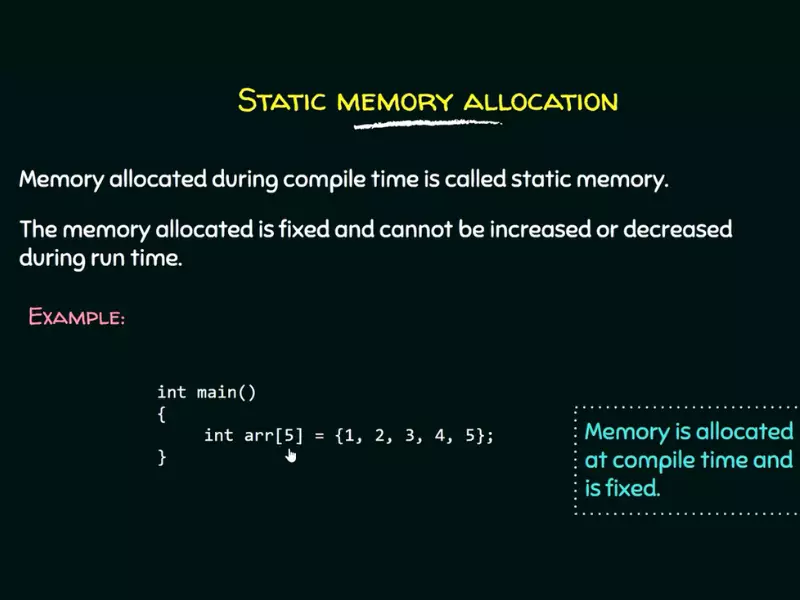Memory allocation is a critical aspect of programming that directly impacts the efficiency and performance of software applications. It refers to the process of assigning a specific amount of computer memory to various program elements, such as variables and data structures, during the execution of a program. The way this allocation happens can significantly influence the overall operation of an application, making it essential for programmers to understand the differences between the available methods.
Static and dynamic memory allocation represent two fundamental approaches to managing memory in programming. Static memory allocation assigns memory at compile time, before the application runs, ensuring a fixed amount of memory is reserved for the program’s lifetime. Dynamic memory allocation, on the other hand, allows programs to request and free memory at runtime, offering flexibility and efficient use of resources.
Static memory allocation is predictable and straightforward, making it suitable for scenarios where the amount of memory needed is known in advance and does not change. Dynamic memory allocation excels in situations requiring variable memory size or when the exact amount of memory needed is unknown at compile time. It provides the ability to allocate memory as needed, but it requires careful management to avoid issues such as memory leaks and fragmentation.

Memory Allocation Basics
What is Memory Allocation
In the realm of computer programming, memory allocation is a fundamental concept that involves assigning a specific portion of a computer’s memory to various programs or processes. This allocation is crucial for the execution and functioning of software, ensuring that each application has the necessary resources to run efficiently without interfering with other processes. Memory in computing is not infinite; hence, its effective management is essential for optimal system performance and stability.
At its core, memory allocation allows programs to request and utilize memory space dynamically or statically, depending on their requirements and the programming model used. This process is managed by the operating system, which oversees the distribution of memory to applications, the retrieval of unused memory, and the prevention of memory leaks that can lead to application crashes and system instability.
Types of Memory Allocation
Memory allocation in computer systems can be broadly categorized into two types: static and dynamic. These methods differ in how and when the memory is allocated, affecting the flexibility, efficiency, and complexity of program development and execution.
- Static Memory Allocation: Memory size is determined at compile time, and the allocation does not change at runtime. It is faster and simpler but lacks flexibility.
- Dynamic Memory Allocation: Memory size can change at runtime, allowing for more flexible and efficient use of memory resources but introducing additional complexity and potential for errors.
Understanding the distinctions between these two types of memory allocation is crucial for developers to make informed decisions about managing memory in their applications effectively.
Static Memory Allocation
Definition and Overview
Static memory allocation refers to a process where the memory size for a program is determined and allocated at compile time. Once a program is compiled, the amount of memory it can use is fixed and does not change while the program is running. This method is commonly used for allocating memory for fixed-size variables and arrays.
Characteristics
The key features of static memory allocation include:
- Fixed Size: The memory size does not change at runtime.
- Compile-Time Allocation: Memory is allocated when the program is compiled.
- Efficiency: Offers faster access to memory since the location is known at compile time.
Advantages
The benefits of static memory allocation are significant, especially for applications where performance and memory efficiency are paramount. These include:
- Speed: Access to statically allocated memory is faster because its address is known at compile time.
- Simplicity: Easier to implement, as the memory management aspect is straightforward.
Disadvantages
Despite its advantages, static memory allocation also has limitations:
- Lack of Flexibility: Unable to adjust memory size based on runtime needs, which can lead to inefficient use of memory.
- Potential Waste of Memory: Allocating too much memory for a program that does not use it all can lead to wasted resources.
Dynamic Memory Allocation
Definition and Overview
Dynamic memory allocation, in contrast to static memory allocation, allows programs to request memory at runtime, offering flexibility in how memory is used. This method is essential for applications where the amount of data to be processed is not known in advance, such as handling variable-sized user inputs or managing data structures that grow and shrink dynamically.
Characteristics
Dynamic memory allocation is characterized by:
- Runtime Allocation: Memory is allocated and freed during the program’s execution.
- Variable Size: The amount of memory can change as needed by the program.
- Management Overhead: Requires explicit allocation and deallocation.
Advantages
The flexibility and efficiency provided by dynamic memory allocation make it a powerful tool for developers:
- Flexibility: Can adjust memory usage based on the program’s needs at runtime.
- Efficient Use of Memory: Allocates only the amount of memory actually needed, potentially reducing waste.
Disadvantages
However, dynamic memory allocation comes with its challenges:
- Complexity: Managing memory dynamically requires careful programming to avoid errors.
- Memory Leaks: Failure to properly free allocated memory can lead to memory leaks, affecting system performance and stability.

Comparing Static and Dynamic Allocation
Performance
When evaluating static versus dynamic memory allocation, performance and speed are pivotal factors. Static allocation shines in scenarios where execution speed is critical. Since the memory is allocated at compile time, the access time during runtime is minimal, enhancing the program’s performance. This immediate access is due to the known memory address, which eliminates the need for additional computation or lookup at runtime.
Dynamic allocation, on the other hand, offers unmatched flexibility but at the cost of additional overhead. The act of allocating and deallocating memory at runtime can introduce delays, especially in scenarios where memory management operations are frequent. However, for applications that require adaptable memory usage, the benefits of dynamic allocation often outweigh these performance costs.
Use Cases
The choice between static and dynamic allocation depends on specific use cases and requirements of the application:
- Static Allocation: Ideal for applications where the memory usage is predictable and does not change over time. This includes embedded systems, real-time applications, and situations where maximum performance is essential.
- Dynamic Allocation: Suited for applications that require flexible memory usage, such as handling varying amounts of data or managing complex data structures like linked lists, graphs, and dynamic arrays.
Memory Management
Memory management practices differ significantly between static and dynamic allocation:
- Static Allocation: Requires minimal management since the memory is allocated and deallocated automatically by the compiler. However, developers must carefully plan their memory usage to avoid waste and ensure they do not exceed the available memory.
- Dynamic Allocation: Demands proactive memory management, including the allocation and deallocation of memory blocks. Developers must implement mechanisms to avoid memory leaks and ensure efficient use of memory resources.
Best Practices
For Static Allocation
Adhering to best practices for static memory allocation can significantly enhance program stability and efficiency:
- Plan Ahead: Estimate the program’s memory requirements during the design phase to avoid over or under allocation.
- Optimize Data Structures: Use fixed-size data structures wisely to minimize memory waste.
- Monitor Memory Usage: Regularly check the memory consumption during development to ensure the allocated memory aligns with actual usage.
For Dynamic Allocation
Effective management of dynamic memory allocation requires a more meticulous approach:
- Initialize Properly: Ensure that newly allocated memory is properly initialized to prevent undefined behavior.
- Free Memory: Always deallocate memory that is no longer needed to avoid memory leaks.
- Use Smart Pointers (where applicable): In languages like C++, smart pointers can automate memory management, reducing the risk of memory leaks.
- Error Handling: Implement robust error handling for allocation failures to maintain program stability.
FAQs
What is Memory Allocation?
Memory allocation is the process through which computer programs assign memory space to store variables, data structures, and other program elements. It is fundamental to programming, allowing efficient use of memory resources and affecting program performance.
How Does Static Memory Allocation Differ from Dynamic?
Static memory allocation reserves a fixed amount of memory for the program’s variables and structures at compile time. In contrast, dynamic memory allocation allows programs to request memory at runtime, offering flexibility to allocate and free memory as needed.
When Should I Use Dynamic Memory Allocation?
Dynamic memory allocation should be used when the amount of memory needed cannot be determined before runtime or when the memory requirement of the application may change during execution. It is ideal for dealing with variable-sized data structures like linked lists and resizable arrays.
Are There Any Risks Associated with Dynamic Memory Allocation?
Yes, dynamic memory allocation introduces risks such as memory leaks, where allocated memory is not properly freed, and memory fragmentation, which can reduce performance. Proper memory management practices are essential to mitigate these risks.
Conclusion
Choosing the right type of memory allocation is crucial for developing efficient and reliable software. While static memory allocation offers simplicity and predictability, dynamic memory allocation provides the flexibility needed for handling more complex, variable data structures and scenarios. Understanding the differences between these two allocation types enables programmers to make informed decisions that best suit the needs of their applications.
Developers should consider the specific requirements of their projects, including performance needs and memory usage patterns, to determine the most appropriate memory allocation strategy. Whether leveraging the predictability of static allocation or the flexibility of dynamic allocation, effective memory management is key to optimizing application performance and ensuring resource efficiency.
